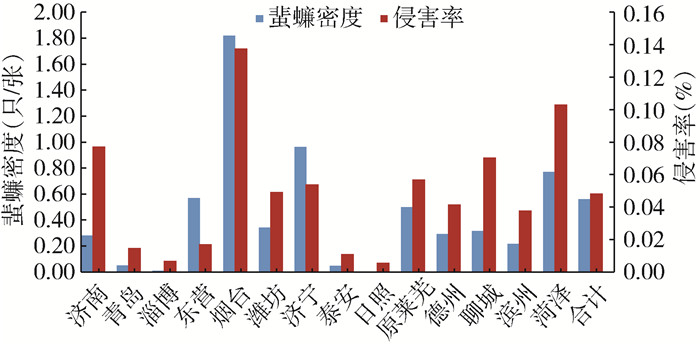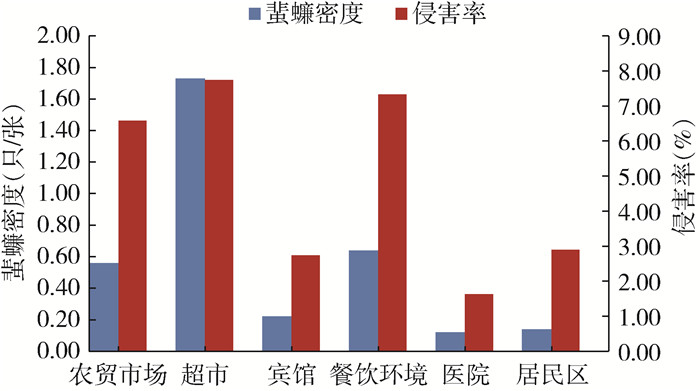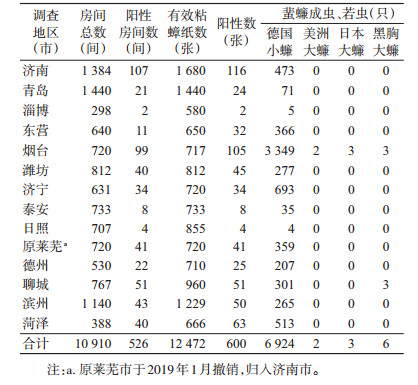引用本文 | 0 |
刘峰, 刘亚楠, 孙钦同, 景晓, 赵志刚, 王学军, 康殿民. 山东省2019年蜚蠊监测分析[J]. 中国媒介生物学及控制杂志, 2020, 31(4): 477-480.

LIU Feng, LIU Ya-nan, SUN Qin-tong, JING Xiao, ZHAO Zhi-gang, WANG Xue-jun, KANG Dian-min. Surveillance and analysis of cockroaches in Shandong province, China, 2019[J]. Chin J Vector Biol & Control, 2020, 31(4): 477-480.

山东省2019年蜚蠊监测分析
刘峰1

,
刘亚楠2


,
孙钦同1
,
景晓1
,
赵志刚1
,
王学军1


,
康殿民1
1 山东省疾病预防控制中心病媒生物防制所, 山东 济南 250014;
2 济南市妇幼保健院, 山东 济南 250001
收稿日期: 2020-04-26
基金项目: 国家科技重大专项(2017ZX10303404);山东省医药卫生科技发展计划(2009HW55,2017WS868)
摘要: 目的 了解山东省各地区城市蜚蠊种类、密度、侵害率、分布特点及季节消长趋势等变化规律,为蜚蠊防治和爱国卫生工作提供依据。方法 采用粘捕法收集蜚蠊,各监测点每月监测1次,选择餐饮环境、居民区、宾馆、医院、农贸市场和超市,每处布放不少于10张粘蟑纸,晚放晨收,记录粘捕到的蜚蠊种类以及雌、雄成虫和若虫数,并记录有效粘蟑纸数。结果 2019年共粘捕蜚蠊6 935只,经鉴定分别为德国小蠊、美洲大蠊、日本大蠊和黑胸大蠊共4种。蜚蠊年平均密度为0.56只/张,其中超市蜚蠊密度最高为1.73只/张,医院蜚蠊密度最低为0.12只/张;德国小蠊占捕获总数的99.84%,为优势种;蜚蠊年平均侵害率为4.81%,其中超市侵害率最高为7.74%,医院侵害率最低为1.63%。密度季节消长有7和11月2个高峰,侵害率季节消长呈单峰型,最高峰在7月为7.05%。结论 山东省城市环境德国小蠊为优势种;在超市、农贸市场、餐饮环境蜚蠊密度和侵害率较高,7和11月为高峰期,相关部门应高度重视,采取综合防制措施降低蜚蠊密度,减少蜚蠊对居民生活环境侵害和传播疾病风险。
关键词:
蜚蠊 密度 种类 侵害率 季节消长
Surveillance and analysis of cockroaches in Shandong province, China, 2019
LIU Feng1

,
LIU Ya-nan2


,
SUN Qin-tong1
,
JING Xiao1
,
ZHAO Zhi-gang1
,
WANG Xue-jun1


,
KANG Dian-min1
1 Shandong Center for Disease Control and Prevention, Ji′nan 250014, Shandong Province, China;
2 Ji'nan City Maternal and Child Health Care Hospital
Supported by the National Major Science and Technology Project of China (No. 2017ZX100303404) and Shandong Provincial Medicine and Health Technology Development Plan (No. 2009HW55, 2017WS868)
Abstract: Objective To investigate the changes in species, density, infestation rate, distribution characteristics, and seasonal fluctuation of urban cockroaches in various regions of Shandong province, China, and to provide a basis for cockroach prevention and patriotic health work. Methods The sticky trap method was used to collect cockroaches. The surveillance sites in various cities were monitored once a month. Restaurants, residential areas, hotels, hospitals, farmers' markets, and supermarkets were selected. Sticky trap papers were placed in the nighttime and collected in the morning, with no less than 10 sheets at each site. The species of cockroaches captured, the number of female and male adults and nymphs, and the number of effective sticky trap papers were recorded. Results A total of 6 935 cockroaches were trapped in 2019, which were identified as 4 species:Blattella germanica, Periplaneta americana, P. japonica, and P. fuliginosa. The mean annual density of cockroaches was 0.56 cockroaches/sheet, of which supermarkets had the highest density (1.73 cockroaches/sheet) and hospitals had the lowest density (0.12 cockroaches/sheet); the dominant species B. germanica accounted for 99.84% of the total cockroaches; the mean annual infestation rate of cockroaches was 4.81%, of which supermarkets had the highest infestation rate (7.74%) and hospitals had the lowest rate (1.63%). The seasonal fluctuation of cockroach density had two peak periods in July and November; the seasonal fluctuation of infestation rate showed a unimodal trend, reaching its peak (7.05%) in July. Conclusion Blattella germanica is the dominant species in urban habitats of Shandong province; cockroach density and invasion rate in supermarkets, farmers' markets, and restaurants are relatively high, with the peak in July and November. Relevant departments should attach great importance to it and take comprehensive control measures to reduce the cockroach density, so as to reduce the invasion of cockroaches to residents' living environment and the risk of spreading diseases.
Key words:
Cockroach Density Species Infestation rate Seasonal fluctuation
蜚蠊是重要的城市害虫,也是重要的病媒生物,严重骚扰人们的休息睡眠及污染食物等;蜚蠊可传播痢疾、副霍乱、伤寒、肝炎、结核病、白喉、猩红热、蛔虫病等疾病,影响居民身体健康。近年来蜚蠊密度和侵害率不断上升[1],为更好地预防控制蜚蠊所致疾病的发生和流行,根据《全国病媒生物监测方案(试行)》方法,2019年我们对山东省居民区蜚蠊种群分布、密度、侵害率及季节消长趋势等进行了监测,现将结果报告如下。
1 材料与方法
1.1 监测点的选择 山东省14个地级市设为相对固定监测点,每个地区选择3个县(区),随机选择餐饮环境2处,居民区、宾馆、医院、农贸市场、超市各1处。
1.2 监测时间及材料 2019年全年进行监测,每月中旬监测1次。采用粘蟑纸,规格为17 cm×10 cm,山东某公司生产。
1.3 监测方法 采用粘捕法,对山东省14个地区的监测点进行蜚蠊密度和侵害率调查,以新鲜面包为诱饵,在粘蟑纸中间部位放2 g诱饵,每个标准间(约15 m2)放置1张,将其放置于蜚蠊经常栖息活动地点,每处监测点布放10张粘蟑纸。于18:00布放,翌日06:00收回。对1周内药物处理过的场所不再选择作为监测点,每次监测时,粘蟑纸都必须更新[2]。
1.4 统计和计算 捕获的蜚蠊总数是指粘蟑纸粘捕到的成、若虫总数。登记粘捕到的蜚蠊种类、成虫(雌、雄)、若虫数。监测现场记录回收的粘蟑纸总数,统计蜚蠊侵害率和密度。采用Excel 2010软件进行统计分析。
2 结果
2.1 蜚蠊种类及构成 2019年全年共捕获蜚蠊4种,经鉴定为姬蠊科(Phyllodromiidae)小蠊属(Blattella)的德国小蠊(B. germanica);蜚蠊科(Blattidae)大蠊属(Periplaneta)分别有美洲大蠊(P. americana)、日本大蠊(P. japonica)和黑胸大蠊(P. fuliginosa)。全省共布放粘蟑纸12 472张,捕获蜚蠊6 935只,其中德国小蠊6 924只,占捕获总数的99.84%;其他种类构成见表 1。
表 1 2019年山东省14个地区捕获蜚蠊情况
Table 1 Data on cockroaches captured in 14 regions of Shandong province, 2019
2.2 蜚蠊密度及侵害率
2.2.1 不同地区蜚蠊密度 2019年各监测点共收回有效粘蟑纸12 472张,其中阳性粘蟑纸600张,共粘捕蜚蠊6 935只,蜚蠊密度为0.56只/张。其中烟台市蜚蠊密度最高为1.82只/张;淄博市蜚蠊密度最低为0.01只/张,见图 1。
2.2.2 不同地区蜚蠊侵害率 2019年山东省各地区回收粘蟑纸12 472张,其中阳性粘蟑纸600张,年侵害率为4.81%,与2016-2018年侵害率(分别为7.68%、8.42%和3.79%)比较呈下降趋势。山东省烟台和菏泽市蜚蠊侵害率较高,分别为13.75%和10.30%;淄博和日照市蜚蠊侵害率较低,均为1.45%。各地区蜚蠊侵害率见图 1。
2.2.3 不同生境蜚蠊密度 2019年各地区不同生境蜚蠊密度以超市最高为1.73只/张,宾馆、居民区和医院蜚蠊密度均较低,分别为0.22、0.14和0.12只/张,见图 2。
2.2.4 不同生境蜚蠊侵害率 蜚蠊侵害率较高的分别是超市、餐饮环境和农贸市场,分别为7.74%、7.33%和6.58%,宾馆和医院蜚蠊侵害率较低,分别为2.74%和1.63%,见图 2。
2.3 蜚蠊密度及侵害率季节消长
2.3.1 蜚蠊密度季节消长 蜚蠊密度7和11月有2个高峰,7月密度最高为0.74只/张,11月为0.72只/张;5-7月为密度较高的平台期,见图 3。
2.3.2 蜚蠊侵害率季节消长 2019年蜚蠊侵害率季节消长呈单峰曲线,最高峰在7月为7.05%,全年侵害率季节消长变化不大,数值范围在1.63%~7.74%之间(图 3)。
3 讨论 20世纪90年代中后期山东省蜚蠊优势种为美洲大蠊和黑胸大蠊。2019年山东省14个地区监测到德国小蠊、美洲大蠊、日本大蠊和黑胸大蠊,德国小蠊占99.84%,为绝对优势种[3],与大连、武汉和深圳市优势种相一致[4]。德国小蠊适应能力强,繁殖快,其侵害范围越来越广[5]。2019年山东省蜚蠊密度季节消长呈现双峰曲线,7月为第1个高峰期,11月是次高峰期,前者因季节原因温度持续升高,蜚蠊密度增加,次高峰期可能与11月开始的供暖有关[6]。蜚蠊侵害率季节消长变化趋势呈单峰曲线,最高峰值在7月,全年侵害率与密度季节消长高峰期吻合。2019年蜚蠊密度与2016-2018年全省蜚蠊密度比较呈下降趋势。
各地区不同环境中蜚蠊密度以超市最高,其次为餐饮环境、农贸市场和宾馆,居民区和医院较低,超市蜚蠊密度比平均密度高出2倍,可能因素有3点:山东省各地区部分开放式农贸市场取消造成大型超市人流物流增加;大型超市有空调和暖气,室温适宜蜚蠊生存;大型超市发展较快,各项设施和防控措施未及时跟上。蜚蠊在全省快速扩张侵袭,给山东省病媒生物防制带来挑战。
调查结果显示,山东省各地区蜚蠊侵害程度不一,东部沿海经济发达地区侵害率较高,西部经济欠发达地区侵害率较低。2019年青岛市及周边地区侵害率较低,可能与举办中国海军成立70周年海上阅兵等大型活动期间加强病媒生物防制有关。根据蜚蠊生态习性和季节消长规律,可以在其繁殖高峰期来临前,统一开展季节性综合环境整治,积极开展爱国卫生运动,对有害生物防制专业服务人员进行岗前培训,以积极有效的综合防制方法降低蜚蠊密度[7],将蜚蠊侵害率控制在较低范围内,严控蜚蠊对人群健康的危害。
参考文献
| [1] |
郭慧, 王高明, 鲁怡欣, 等. 武汉市2007-2016年蜚蠊监测结果分析[J]. 中国媒介生物学及控制杂志, 2018, 29(2): 168-171. Guo H, Wang GM, Lu YX, et al. Analysis of cockroach surveillance in Wuhan city from 2007 to 2016[J]. Chin J Vector Biol Control, 2018, 29(2): 168-171. DOI:10.11853/j.issn.1003.8280.2018.02.013 |
|
| [2] |
中华人民共和国卫生部.全国病媒生物监测方案(试行)[Z].北京: 中国疾病预防控制中心, 2005.
Ministry of Health of the People's Republic of China. National vector surveillance program (Trial)[Z]. Beijing: Chinese Center for Disease Control and Prevention, 2005.
|
|
| [3] |
吴海霞, 鲁亮, 孟凤霞, 等. 2006-2015年我国蜚蠊监测报告[J]. 中国媒介生物学及控制杂志, 2018, 29(2): 113-119. Wu HX, Lu L, Meng FX, et al. Reports on national surveillance of cockroaches in China, 2006-2015[J]. Chin J Vector Biol Control, 2018, 29(2): 113-119. DOI:10.11853/j.issn.1003.8280.2018.02.001 |
|
| [4] |
蒋璐, 王飞, 王丹华, 等. 上海市虹口区德国小蠊对5种杀虫剂的抗性调查[J]. 中华卫生杀虫药械, 2016, 22(6): 622-623. Jiang L, Wang F, Wang DH, et al. Resistance of Blattella germanica to five insecticides in Hongkou district of Shanghai[J]. Chin J Hyg Insect Equip, 2016, 22(6): 622-623. DOI:10.19821/j.1671-2781.2016.06.032 |
|
| [5] |
刘峰, 刘亚楠, 景晓, 等. 2010-2015年山东省居民区蟑螂监测分析[J]. 中华卫生杀虫药械, 2019, 25(2): 135-137. Liu F, Liu YN, Jing X, et al. Analysis on monitoring of cockroaches in residential areas in Shandong province from 2010 to 2015[J]. Chin J Hyg Insect Equip, 2019, 25(2): 135-137. DOI:10.19821/j.1671-2781.2019.02.013 |
|
| [6] | |
|
| [7] | |
|
 2020, Vol. 31
2020, Vol. 31










